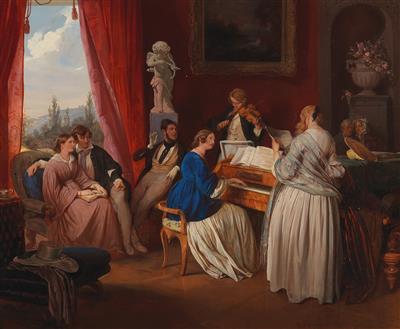Josef Danhauser

(Vienna 1805–1845)
The Family Concert, signed, dated Jos. Danhauser 1841, on the reverse remains of old labels and monogram F. G., oil on panel, 42 x 52 cm, framed, cradled, (W)
Catalogued and illustrated in:
Sabine Grabner, Der Maler Josef Danhauser, Monografie und Werkverzeichnis, Böhler Verlag, Vienna, Cologne, Weimar 2011, ill. p. 101, CR 283, current ownership unknown.
Provenance:
Neumann Collection c. 1840/41;
Collection of Daniel Bernhard Baron von Eskeles (1803–1876), Vienna 1850s;
Collection of Leopoldine Mayer, née Stuhlberger (1831–1888), Vienna;
Collection of Carl Leistler (1816–1907), Vienna;
his sale P. Kaeser Vienna, 29 April 1868, lot 29;
David Singer Collection Vienna, until 1877;
Collection of Dr. Karl Conn (1850–1900);
his sale, S. Kende Vienna, 9 March 1900, lot 16;
Collection of Johann von Medinger (1846–1908), Vienna;
his heirs;
Private collection, Switzerland.
Josef Danhauser was able to portray people with their virtues and vices like no other artist of his time. A closer look at his pictures reveals to the viewer his pictorial language enriched with symbols and not without humorous features. He thus sets his scenes within the everyday life of his age and depicts human nature in its many facets. At the beginning of his career, he devoted himself to history painting and to the portrayal of religious themes. The depiction of genre scenes, which established his reputation as a sought-after and celebrated painter, would subsequently shape the scope of his artistic work. The artist owes to his salon and garden scenes his position as a much-praised painter of his time, who always received positive reviews in the press, despite the public’s initial detachment from his works.
Danhauser also conveyed biblical scenes in a vocabulary of contemporary forms, as can be recognised in the painting “The Rich Glutton”, inspired by a scene from the New Testament. The response of the public and the art world to this work was outstanding. The painting established his breakthrough in 1836 and gained a (moral) sequel in its counterpart, “The Monastery Soup”, completed two years later. The rich glutton has lost his whole fortune and must now go to a food kitchen. The tide has turned, revealing the transience of superficial things. For the work shown here, too, the artist has created a further continuation of the story. Just as with “The Monastery Soup”, the content is discernible only through a knowledge of its predecessor, which allows us to grasp its deeper meaning. The painting shows a concert in a salon. The second title of the picture, “The Search for a Bride”, is unfolded on closer inspection: the singer standing at the piano is being thoroughly admired by the casually sitting man. The statue of Cupid above him aims his arrow on the young woman. As Sabine Grabner so fittingly puts it: “with a blissful facial expression he follows the notes and is unable to turn his gaze away from the singer. The fire of love burgeoning within him is symbolised by the sculpture on the pedestal behind him: it represents Cupid, who spreads his bow and fixes his arrow on the singer”. It is not easy to identify the exact palace in which the scene takes place. Indications from old scholarship which name the Palais Eskeles in Baden or Hietzig as possible locations cannot be verified. Only the couple on the sofa can unequivocally be identified as the astronomer Karl Ludwig von Littrow and his wife Auguste, since Danhauser completed a portrait of them in the same year in this precise pose. (from: Sabine Grabner, Josef Danhauser, Biedermeierzeit im Bild, Monografie und Werkverzeichnis, Agnes Husslein-Arco (ed.), Belvedere Werkverzeichnisse vol. 1, Böhlau Verlag Vienna, Cologne, Weimar 2011, p. 101; see fig. 163, Grabner ibid.) The famous astronomer Littrow, who had a significant involvement in the new construction of the astronomical observatory in Vienna, is also the uncle of the painter Lea von Littrow.
The present work finds its aforementioned sequel in the painting “In the Painter’s Studio”, in which the former singer now poses for a painter whilst the man beside her – by now probably her husband – watches the painter like a hawk.
Comparisons with Josef Danhauser’s self-portraits lead Sabine Grabner to the conclusion that Danhauser portrays himself in the first painting as a violinist and then as a painter (see Grabner, p. 101 f.).
The “Family Concert” is an appealing example of Danhauser’s penchant for depicting scenes from bourgeois everyday life besides moral and historicising subjects. The bourgeois salon, the meeting point for social gatherings, provides the setting for such intimate scenes.
Specialist: Dr. Christl Wolf
 Dr. Christl Wolf
Dr. Christl Wolf
+43-1-515 60-377
19c.paintings@dorotheum.at
27.04.2017 - 18:00
- Realized price: **
-
EUR 40,965.-
- Estimate:
-
EUR 30,000.- to EUR 50,000.-
Josef Danhauser
(Vienna 1805–1845)
The Family Concert, signed, dated Jos. Danhauser 1841, on the reverse remains of old labels and monogram F. G., oil on panel, 42 x 52 cm, framed, cradled, (W)
Catalogued and illustrated in:
Sabine Grabner, Der Maler Josef Danhauser, Monografie und Werkverzeichnis, Böhler Verlag, Vienna, Cologne, Weimar 2011, ill. p. 101, CR 283, current ownership unknown.
Provenance:
Neumann Collection c. 1840/41;
Collection of Daniel Bernhard Baron von Eskeles (1803–1876), Vienna 1850s;
Collection of Leopoldine Mayer, née Stuhlberger (1831–1888), Vienna;
Collection of Carl Leistler (1816–1907), Vienna;
his sale P. Kaeser Vienna, 29 April 1868, lot 29;
David Singer Collection Vienna, until 1877;
Collection of Dr. Karl Conn (1850–1900);
his sale, S. Kende Vienna, 9 March 1900, lot 16;
Collection of Johann von Medinger (1846–1908), Vienna;
his heirs;
Private collection, Switzerland.
Josef Danhauser was able to portray people with their virtues and vices like no other artist of his time. A closer look at his pictures reveals to the viewer his pictorial language enriched with symbols and not without humorous features. He thus sets his scenes within the everyday life of his age and depicts human nature in its many facets. At the beginning of his career, he devoted himself to history painting and to the portrayal of religious themes. The depiction of genre scenes, which established his reputation as a sought-after and celebrated painter, would subsequently shape the scope of his artistic work. The artist owes to his salon and garden scenes his position as a much-praised painter of his time, who always received positive reviews in the press, despite the public’s initial detachment from his works.
Danhauser also conveyed biblical scenes in a vocabulary of contemporary forms, as can be recognised in the painting “The Rich Glutton”, inspired by a scene from the New Testament. The response of the public and the art world to this work was outstanding. The painting established his breakthrough in 1836 and gained a (moral) sequel in its counterpart, “The Monastery Soup”, completed two years later. The rich glutton has lost his whole fortune and must now go to a food kitchen. The tide has turned, revealing the transience of superficial things. For the work shown here, too, the artist has created a further continuation of the story. Just as with “The Monastery Soup”, the content is discernible only through a knowledge of its predecessor, which allows us to grasp its deeper meaning. The painting shows a concert in a salon. The second title of the picture, “The Search for a Bride”, is unfolded on closer inspection: the singer standing at the piano is being thoroughly admired by the casually sitting man. The statue of Cupid above him aims his arrow on the young woman. As Sabine Grabner so fittingly puts it: “with a blissful facial expression he follows the notes and is unable to turn his gaze away from the singer. The fire of love burgeoning within him is symbolised by the sculpture on the pedestal behind him: it represents Cupid, who spreads his bow and fixes his arrow on the singer”. It is not easy to identify the exact palace in which the scene takes place. Indications from old scholarship which name the Palais Eskeles in Baden or Hietzig as possible locations cannot be verified. Only the couple on the sofa can unequivocally be identified as the astronomer Karl Ludwig von Littrow and his wife Auguste, since Danhauser completed a portrait of them in the same year in this precise pose. (from: Sabine Grabner, Josef Danhauser, Biedermeierzeit im Bild, Monografie und Werkverzeichnis, Agnes Husslein-Arco (ed.), Belvedere Werkverzeichnisse vol. 1, Böhlau Verlag Vienna, Cologne, Weimar 2011, p. 101; see fig. 163, Grabner ibid.) The famous astronomer Littrow, who had a significant involvement in the new construction of the astronomical observatory in Vienna, is also the uncle of the painter Lea von Littrow.
The present work finds its aforementioned sequel in the painting “In the Painter’s Studio”, in which the former singer now poses for a painter whilst the man beside her – by now probably her husband – watches the painter like a hawk.
Comparisons with Josef Danhauser’s self-portraits lead Sabine Grabner to the conclusion that Danhauser portrays himself in the first painting as a violinist and then as a painter (see Grabner, p. 101 f.).
The “Family Concert” is an appealing example of Danhauser’s penchant for depicting scenes from bourgeois everyday life besides moral and historicising subjects. The bourgeois salon, the meeting point for social gatherings, provides the setting for such intimate scenes.
Specialist: Dr. Christl Wolf
 Dr. Christl Wolf
Dr. Christl Wolf
+43-1-515 60-377
19c.paintings@dorotheum.at
|
Buyers hotline
Mon.-Fri.: 10.00am - 5.00pm
kundendienst@dorotheum.at +43 1 515 60 200 |
| Auction: | 19th Century Paintings |
| Auction type: | Saleroom auction |
| Date: | 27.04.2017 - 18:00 |
| Location: | Vienna | Palais Dorotheum |
| Exhibition: | 15.04. - 27.04.2017 |
** Purchase price incl. charges and taxes(Country of delivery: Austria)
It is not possible to turn in online buying orders anymore. The auction is in preparation or has been executed already.
More objects by this artist
-

Starting bid:
EUR 400.- -

Josef Danhauser zugeschrieben/attributed
Starting bid:
EUR 300.-
